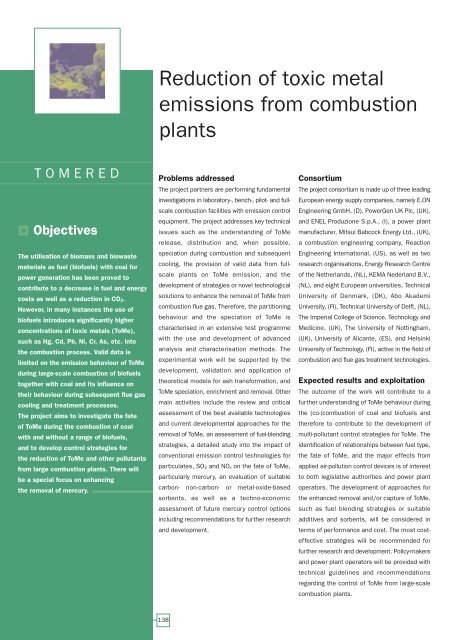European Bio-Energy Projects
European Bio-Energy Projects
European Bio-Energy Projects
Create successful ePaper yourself
Turn your PDF publications into a flip-book with our unique Google optimized e-Paper software.
TOMERED<br />
Objectives<br />
The utilisation of biomass and biowaste<br />
materials as fuel (biofuels) with coal for<br />
power generation has been proved to<br />
contribute to a decrease in fuel and energy<br />
costs as well as a reduction in CO2.<br />
However, in many instances the use of<br />
biofuels introduces significantly higher<br />
concentrations of toxic metals (ToMe),<br />
such as Hg, Cd, Pb, Ni, Cr, As, etc. into<br />
the combustion process. Valid data is<br />
limited on the emission behaviour of ToMe<br />
during large-scale combustion of biofuels<br />
together with coal and its influence on<br />
their behaviour during subsequent flue gas<br />
cooling and treatment processes.<br />
The project aims to investigate the fate<br />
of ToMe during the combustion of coal<br />
with and without a range of biofuels,<br />
and to develop control strategies for<br />
the reduction of ToMe and other pollutants<br />
from large combustion plants. There will<br />
be a special focus on enhancing<br />
the removal of mercury.<br />
Reduction of toxic metal<br />
emissions from combustion<br />
plants<br />
Problems addressed<br />
The project partners are performing fundamental<br />
investigations in laboratory-, bench-, pilot- and fullscale<br />
combustion facilities with emission control<br />
equipment. The project addresses key technical<br />
issues such as the understanding of ToMe<br />
release, distribution and, when possible,<br />
speciation during combustion and subsequent<br />
cooling, the provision of valid data from fullscale<br />
plants on ToMe emission, and the<br />
development of strategies or novel technological<br />
solutions to enhance the removal of ToMe from<br />
combustion flue gas. Therefore, the partitioning<br />
behaviour and the speciation of ToMe is<br />
characterised in an extensive test programme<br />
with the use and development of advanced<br />
analysis and characterisation methods. The<br />
experimental work will be supported by the<br />
development, validation and application of<br />
theoretical models for ash transformation, and<br />
ToMe speciation, enrichment and removal. Other<br />
main activities include the review and critical<br />
assessment of the best available technologies<br />
and current developmental approaches for the<br />
removal of ToMe, an assessment of fuel-blending<br />
strategies, a detailed study into the impact of<br />
conventional emission control technologies for<br />
particulates, SO2 and NOx on the fate of ToMe,<br />
particularly mercury, an evaluation of suitable<br />
carbon- non-carbon- or metal-oxide-based<br />
sorbents, as well as a techno-economic<br />
assessment of future mercury control options<br />
including recommendations for further research<br />
and development.<br />
138<br />
Consortium<br />
The project consortium is made up of three leading<br />
<strong>European</strong> energy supply companies, namely E.ON<br />
Engineering GmbH, (D), PowerGen UK Plc, (UK),<br />
and ENEL Produzione S.p.A., (I), a power plant<br />
manufacturer, Mitsui Babcock <strong>Energy</strong> Ltd., (UK),<br />
a combustion engineering company, Reaction<br />
Engineering International, (US), as well as two<br />
research organisations, <strong>Energy</strong> Research Centre<br />
of the Netherlands, (NL), KEMA Nederland B.V.,<br />
(NL), and eight <strong>European</strong> universities, Technical<br />
University of Denmark, (DK), Abo Akademi<br />
University, (FI), Technical University of Delft, (NL),<br />
The Imperial College of Science, Technology and<br />
Medicine, (UK), The University of Nottingham,<br />
(UK), University of Alicante, (ES), and Helsinki<br />
University of Technology, (FI), active in the field of<br />
combustion and flue gas treatment technologies.<br />
Expected results and exploitation<br />
The outcome of the work will contribute to a<br />
further understanding of ToMe behaviour during<br />
the (co-)combustion of coal and biofuels and<br />
therefore to contribute to the development of<br />
multi-pollutant control strategies for ToMe. The<br />
identification of relationships between fuel type,<br />
the fate of ToMe, and the major effects from<br />
applied air-pollution control devices is of interest<br />
to both legislative authorities and power plant<br />
operators. The development of approaches for<br />
the enhanced removal and/or capture of ToMe,<br />
such as fuel blending strategies or suitable<br />
additives and sorbents, will be considered in<br />
terms of performance and cost. The most costeffective<br />
strategies will be recommended for<br />
further research and development. Policy-makers<br />
and power plant operators will be provided with<br />
technical guidelines and recommendations<br />
regarding the control of ToMe from large-scale<br />
combustion plants.

















